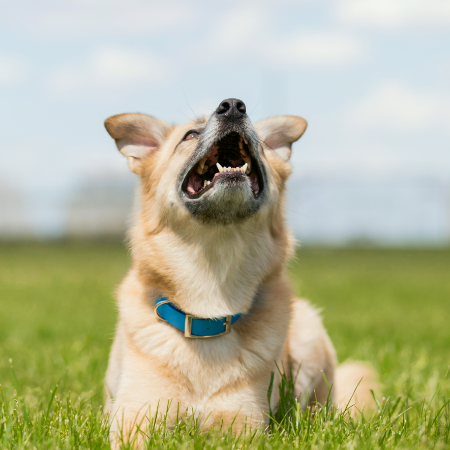The Science of Dog Barking: What Different Barks Mean
In addition to their affection and loyalty, dogs are famous for barking. However, have you ever questioned why your dog barks in so many distinct ways? Dog barking science explores the sounds our furry pals create and the messages they are attempting to convey. Every bark has a distinct rhythm, tone, and even function. There is a “bark language” that dogs use to communicate their emotions, which can range from eagerness to fear, impatience to amusement.
Here is a guide to help you understand the many dog barks, their causes, and how to react in a way that strengthens your bond with your dog.
Why Do Dogs Bark?
Dogs communicate by barking, just like people do by talking, laughing, or yelling. Dogs use body language and noises to communicate, whereas people use words, gestures, and facial emotions. Dogs use barking to express wants, emotions, alerts, and even boredom.

It’s like learning a new language to comprehend dog barking. With a little observation, you can begin to figure out what your dog is trying to tell you with each bark. According to studies, a dog’s mental state, degree of enthusiasm, and intention can all be inferred from their bark. Let’s examine a few typical bark types.
1. The “Hello, Human!” Bark
You are familiar with this bark if your dog always greets you with a string of brief, joyful barks when you enter the house. It is swift, light, and has a “smiling” face and a wagging tail. “I missed you!” says this bark. Greetings again!” or just “Hey, you’re here! Cheers!
Pattern and Tone: Brief, high-pitched outbursts.
Emotion: Joy and excitement.
What It Means: When a dog is excited, friendly, or feels safe, they frequently bark in this manner.
How to React: Express love. Dogs adore it when we make them happy in return. Pet, scratch, and perhaps even give your dog a treat.
2. The “Something’s Wrong!” Alert Bark
The alert bark of a dog can be abrupt, piercing, and repetitive. Your dog will bark to alert you to something strange when they see someone passing by the window or hear a strange sound.
Tone and Pattern: Loud, repeated, mid- to high-pitched is the tone and pattern.
Emotion: Vigilance, interest, or moderate worry.
What It Means: Your dog is attempting to alert you to an oddity or possible danger.
How to React: Calmly approach and observe the situation. A simple “Thank you, that’s enough” will comfort your dog that you’re in control of the situation. Let them see you handle it. This informs them that their protective role is finished.
3. The “Back Off!” Defensive Bark
If a dog feels threatened or if someone is approaching their territory too closely, they may bark defensively. This bark frequently has a loud, hostile sound, occasionally accompanied by growling. It’s an obvious warning to avoid it.
Pattern and Tone: Long-lasting, low, occasionally accompanied by growling.
Emotion: Defensiveness or fear.

What It Means: Your dog is afraid and attempting to defend their home or themselves, or they feel as though their personal space is being violated.
How to React: Examine the circumstances calmly. Show your dog that you don’t care whether it’s a stranger. To let your dog know that the “threat” isn’t real, try speaking in a calm tone or gently guiding them to a different location.
4. The “I’m So Lonely!” Bark
Since dogs are sociable creatures, some breeds are more likely to experience separation anxiety than others. This may be a “lonely bark” if your dog has been barking for extended periods of time after you get home. It can last for a long period and frequently has a whiny or high-pitched tone.
Tone and Pattern: High-pitched, repeating, with intervals, is the tone and pattern.
Emotion: Anxiety and sadness.
What It Means: Your dog is yelling for companionship or assurance because he feels alone.
How to React: Give them more attention, particularly if they have been by themselves for some time. They might feel less alone if they have interactive toys or background noise (such as TV or soothing music). Dogs who receive regular daily exercise and mental stimulation can also experience less anxiety and loneliness.
5. The “I’m Hurt” or “I’m Scared” Bark
If a dog yelps, it’s usually a sign that they’re in pain or suddenly scared. These barks are sharp, sudden, and often one-off sounds. It might happen if they step on something painful, bump into something, or feel startled by a loud sound.
Tone and Pattern: Sharp, high-pitched, sudden.
Emotion: Pain or fear.
What It Means: Your dog is feeling uncomfortable or scared.
How to Respond: Check them over to see if they’re physically hurt. If they seem okay physically but are still acting anxious, offer gentle reassurance with a soft voice and slow, comforting strokes.
6. The “Let’s Play!” Bark
Have you ever seen your dog bark playfully before running off? Usually accompanied by a play bow (front legs extended forward, butt in the air), this is the “let’s play” bark. This bark is typically higher-pitched, friendly, and playful.
Pattern and Tone: energetic, brief, and high-pitched.
Emotion: Exuberance and playfulness.
What It Means: It indicates that your dog is eager to play or is extending an invitation to other dogs or people to join them.
How to React: Get their favorite toy and get involved! This is how your dog lets you know when they’re ready to go. Playtime keeps children engaged both physically and psychologically and improves your relationship.
7. The “I’m Frustrated!” Bark
Dogs can become irritated at times, particularly if they are confined inside or unable to get to something they desire. This bark is frequently rapid, repetitive, and has a deeper tone. If you ignore a frustrated dog’s attempts to communicate, they may also bark at you.
Pattern and Tone: Rapid, repetitive, typically mid-pitched.
Emotion: Impatience or frustration.
What It Signifies: Your dog feels confined, disregarded, or blocked.
How to React: Make an effort to determine the source of their frustration and take appropriate action. They could require a little more care, mental difficulties, or exercise.
Other Sounds and Body Language Clues
In addition to barking, dogs can communicate through body language and other vocalizations like howling, growling, and whining. A brief summary of several typical sounds and their meanings is provided below:

Whining is typically a request or an indication of nervousness. When they are anxious or want something, dogs will whine.
Growling: Dogs can growl when they feel threatened or defensive, but they can also growl while playing.
Howling: Dogs can communicate over great distances by howling, and many breeds, such as huskies, like howling when they’re happy.
It’s also critical to comprehend the body language associated with each bark. While stiff, raised fur and rigid posture indicate a more protective bark, a relaxed body typically indicates a cheerful bark. It’s simpler to interpret your dog’s feelings and react correctly if you focus on their full body.
Wrapping Up
There is more to dog barking than just sounds. Your dog can use it to communicate anything from playfulness and fear to happiness and loneliness. You can discover a lot about their mental states by observing the frequency, pitch, and tone of their barks.
Gaining an understanding of your dog’s “bark language” will strengthen your bond with them. Whether it’s playtime, consolation, or simply a brief acknowledgment, giving the appropriate response makes your dog feel seen, heard and loved.
Thus, pay close attention the next time your dog barks. They may simply be sharing a story about their day with you. Who knows? You could become an expert dog bark whisperer with practice!
Doglime for more dog-related information.
Tags










